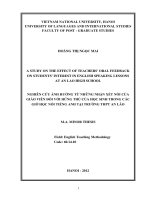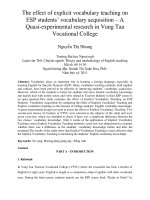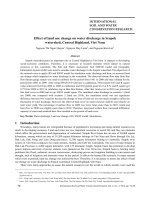The effect of size and growth on leverage evidence in the fishery and real estate industry in vietnam
Bạn đang xem bản rút gọn của tài liệu. Xem và tải ngay bản đầy đủ của tài liệu tại đây (554.57 KB, 73 trang )
THE EFFECT OF SIZE AND GROWTH ON LEVERAGE: EVIDENCE IN THE
FISHERY AND REAL ESTATE INDUSTRY IN VIETNAM
In Partial Fulfillment of the Requirements of the Degree of
MASTER OF BUSINESS ADMINISTRATION
In Finance
By
Mr: Nguyen ManhThang
ID: MBA02032
International University - Vietnam National University HCMC
August 2013
THE EFFECT OF SIZE AND GROWTH ON LEVERAGE: EVIDENCE IN THE
FISHERY AND REAL ESTATE INDUSTRY IN VIETNAM
In Partial Fulfillment of the Requirements of the Degree of
MASTER OF BUSINESS ADMINISTRATION
In Finance
by
Mr: Nguyen Manh Thang
ID: MBA02032
International University - Vietnam National University HCMC
August 2013
Under the guidance and approval of the committee, and approved by all its members,
this thesis has been accepted in partial fulfillment of the requirements for the degree.
Approved:
---------------------------------------------Chairperson
--------------------------------------------Committee member
’
---------------------------------------------Committee member
---------------------------------------------Committee member
--------------------------------------------Committee member
--------------------------------------------Committee member
Acknowledgement
To complete this thesis, I have been benefited from the following people.
First of all, I would like to express my special thanks to my advisor –Doctor.
Nguyen Kim Thu – who recommended the research idea to me and for all the
enthusiastic instruction and encouragement during the time I do this thesis. Besides, I
would like to dedicate my gratitude to IU lecturers who communicated abstruse
knowledge to me during MBA program, and the members of the Examination
Committee for taking time and giving valuable comments to improve this study.
I also want to give my sincere thanks to my friends and my classmate who are
my inspiration and always help me release stressful.
Last but not least, I want to express my loving thanks to my family who always
stand beside me. My greatest gratitude is to my wife, Ngan. My MBA program in IU VNU would have not been completed without her love and encouragement.
HCM City, August 2013
NGUYEN MANH THANG
i
Plagiarism Statements
I would like to declare that, apart from the acknowledged references, this thesis
either does not use language, ideas, or other original material from anyone; or has not
been previously submitted to any other educational and research programs or
institutions. I fully understand that any writings in this thesis contradicted to the above
statement will automatically lead to the rejection from the MBA program at the
International University – Vietnam National University Hochiminh City.
ii
Copyright Statement
This copy of the thesis has been supplied on condition that anyone who consults
it is understood to recognize that its copyright rests with its author and that no quotation
from the thesis and no information derived from it may be published without the
author’s prior consent.
© Nguyen Manh Thang/ MBA 02032/2013
iii
Table of Contents
CHAPTER I – INTRODUCTION ............................................................................................. 1
1.1.
Rationale ................................................................................................................... 3
1.2.
Research objectives.................................................................................................... 6
1.3.
Scope and limitation of the study ............................................................................... 7
1.4.
Research structure...................................................................................................... 7
CHAPTER II – LITERATURE REVIEW ................................................................................. 9
2.1.
Theories and empirical studies that relate to the correlation between size and leverage 9
2.1.1.
Pecking order theory .......................................................................................... 9
2.1.2.
Trade off theory ............................................................................................... 10
2.1.3.
Empirical studies .............................................................................................. 10
2.2. Theories and empirical studies that relate to the correlation between growth and
leverage .............................................................................................................................. 11
2.2.1.
The trade-off theory ......................................................................................... 11
2.2.2.
Empirical studies .............................................................................................. 11
2.3. Other theories and empirical studies that relate to the correlation between controlled
variables and leverage ......................................................................................................... 13
2.3.1.
Model of theories ............................................................................................. 13
2.3.2.
Other empirical studies ..................................................................................... 17
2.3.3.
Previous researches in Vietnam ........................................................................ 22
2.4.
A theoretical model of the determinants of capital structure...................................... 23
2.4.1.
The model ........................................................................................................ 23
CHAPTER III – DATA AND METHODOLOGY ................................................................... 25
3.1.
Sampling design ...................................................................................................... 25
3.2.
Data collection methods ........................................................................................... 25
3.3.
Variables ................................................................................................................. 26
3.4. Size: it is the independence variable in the model and measured by Natural Log
Turnover ............................................................................................................................. 26
3.5.
Growth (investment opportunities) ........................................................................... 27
3.6.
Asset structure ......................................................................................................... 28
3.7.
Non-debt tax shield .................................................................................................. 28
3.8.
Debtors .................................................................................................................... 29
3.9.
Dummy variables ..................................................................................................... 29
iv
3.10.
Framework: ......................................................................................................... 30
CHAPTER IV - FINDINGS .................................................................................................... 33
4.1.
Descriptive Statistics................................................................................................ 33
4.2.
Empirical results ...................................................................................................... 35
CHAPTER V –CONCLUSIONS ............................................................................................ 42
5.1.
Summary of the thesis .............................................................................................. 42
5.2.
Limitations .............................................................................................................. 43
5.3.
Main implications .................................................................................................... 43
5.4.
Suggestion for future research .................................................................................. 44
v
List of Tables
Table 1. Production of fishery by area in Viet Nam ................................................................... 4
Table 2: Predicted signs on the proxies for the competing leverage determinants theories ........ 31
Table 3: Descriptive statistics of all variable of entire sample .................................................. 34
Table 4:Descriptive statistics of all variable of Fishery sector .................................................. 34
Table 5: Descriptive statistics of all variable of Real estate sector ............................................ 34
Table 6: Correlation of independent variables .......................................................................... 35
Table 7: Redundant Fixed Effect Tests .................................................................................... 36
Table 8: Hausman Test result .................................................................................................. 36
Table 9: Fixed effect model ..................................................................................................... 37
Table 10: Fixed effect model in fishery companies .................................................................. 38
Table 11: Fixed effect model in real estate companies ............................................................. 39
vi
List of Abbreviation
Abbreviation
Equivalence
FEM
Fixed Effect Model
Obs.
Observation
OLS
Ordinary Least Square
REM
Random Effect Model
Std. Dev.
Standard Deviation
vii
Abstract
The study analyzes the factors determining the capital structure of the Vietnam
enterprises. The analysis grounds on M&M, the agency theory, trade-off theory and the
pecking order theory. In particular, the study provides a qualitative and quantitative
analysis about relationship between size and leverage, the relationship between growth
and leverage in fishery and real estate industry in HOSE. This analysis bases on
definition of the expected relationships that one might consider between the referred
variables and the total debt ratio. In this regard, the analysis will conduct by means of
considering a survey of 54 companies in Vietnam where a hierarchical regression model
will allow comparison of the hypotheses made.
viii
CHAPTER I – INTRODUCTION
The research provides an explanatory analysis of factors which determine the
capital structure of the Vietnamese enterprises by taking into account different theories.
In particular, the following theories will be considered: (i) the ‘M&M theory’; (ii) the
‘Agency theory’, (iii) the ‘pecking order theory’ and (iiii) the ‘trade-off theory’.
The decision on the capital structure is one of the most debated aspects in
corporate finance.
The decision about the capital structure deals with the best
combination of the different financial fund (equity and debt in short term and long term)
that minimized the cost of capital without compromising the business plan.
There are many studies regarding to the decisions on capital structure and they
all focused on two issues: (i) the optimal debt ratio that maximizes the market value of
the firm, and (ii) factors that influent financial decision.
Indeed, the optimal capital structure is affected by the debt policy of the
company. The very first theories that explained the effect of debt policy on capital
structure is M&M model (Modigliani & Miller, 1958). The main proposition of
Modigliani and Miller (1958) is that the value of a company does not depend on its
financial structure. However, many theories have the converse argument with M&M
such as pecking order theory and the trade-off theory, the agency theory.
According to agency theory, the financial conflict between the organization and
the debt providers lead to two agency relationships. Firstly, the managerial relationship
established between managers and shareholders, between the owners and the
1
management board of the firm. Secondly, the borrowing relationship established
between the shareholders and the lenders The agency theory suggest that debt policy
may reduce agency conflicts that may arise between managers and shareholders. In
general if the agency costs engendered by the existence of outside owners are positive it
will pay the absentee owner to sell out to an owner-manager who can avoid these costs.
The agency costs will affect the market value of the securities of the company. Thus, an
optimal capital structure minimizes the total agency costs. Furthermore, the benefits and
the costs of different capital structures are defined by principal agent conflict of equity
holders and debt. Jensen and Meckling (1976) and Jensen (1986) reported that firm’s
debt had a disciplining effect on scope of action of management
Based on pecking order theory, Myers (1984), Pettit and Singer (1985) said that
the board of management prefer internal funds to external funds. When there are
opportunities for profitable investment, or when financial companies are insufficient, the
board of management prefers borrowing, and only uses share issues as a last way to
finance because they want to avoid sharing the business opportunities with entrants,
since this action transmits negative information to the market (Myers, 1984; Myers and
Majluf, 1984). Equity is only issued if internal funds and debt are not available to the
firm. The Asian case is different, Wiwattanakantang (1999) did not provide a prediction
about the relationship between size and debt. Indeed, all these studies suggest that size
could be positively or negatively related to debt, depending on the relative importance of
pecking order. Fattouh, Scaramozzino and Harris (2005) found significant nonlinearities
in the capital structure’s determinants of South Korean companies from 1992 to 2001. It
could say that the extended version of the pecking order theory included symmetric
2
information. Yau, Lau and Liwan (2008) test the capital structure in Malaysia from 1999
to 2005 and foundfind a negative correlation between external financing needs and longterm debt.
Trade-off theory analyzes the capital structure decisions in a model with taxes,
where interest payment on debt shield profits being taxed. Bradley and Jarrell and Kim
(1984), based on trade-off theory, had been proved that companies increase debt levels
until an additional unit of debt equals the cost of debt in which included the costs of a
higher probability of financial distress with rising debt levels., firm try to reach this
static optimal point, also called target capital structure. Bris, Welch and Zhu (2006)
argue that the utility of tax shield rises with profitability, lower depreciations and higher
tax rates.. In a study in U.S market, Frank, Murray Z. and Vidhan K. Goyal (2009)
reported a support for the trade-off theory.The report had a result of positive correlation
between size and company leverage, the tangible assets.
1.1. Rationale
In the fishery industry, approximately four million people are employed in the
fisheries sector in Viet Nam. According to Post harvest and Marketing Component,
FSPS in 2009, in Vietnam, around 8.5 million people (10% of the total population)
derive their main income from fisheries industry.
Following European Union Economic and Commercial Counselors report, 2008,
fishery sector in Vietnam accounts for 5.8% of national GDP, 7.8% of export turnover
and 10% of the labor force. This sector maintained an impressive production growth rate
of 12% per year for the last twenty years and contributed to economic growth, reducing
3
poverty, sustainable livelihood creation, whilst improving food security and food safety.
Total production had grown from 3,465,915 tons in 2005 to 4,847,620 in 2009 (Table 1).
In which, the Mekong River Delta area has the largest production with more than 50%
of total production.
Table 1. Production of fishery by area in Viet Nam (tons)
(Source: GSO, 2009)
Due to its important role in the Vietnamese economy, the fishery industry has received a
lot of government support, which is represented in the following legal documents:
Decision No.358/QD-TTg on 29 May, 1997 on preferential taxation on the
Exploitation of marine products in offshore areas,
Decision 332/QĐ-TTg to approve the project on Aquaculture Development
Toward 20201.
1
The project focused on total aquaculture development, coasting around VND 40,000 billion,
aims to bring the aquaculture production up to 4.5 million tons and the export value up to US$
5.5 billion by 2020.Source: ARD-VN Economy News (posted on website vietfish.org 10/03/2011)
4
Circular 02/2013/NQ-CP on 07 Jan, 2013 to provide loans and credit for the
fishery industry.
Even though, the fishery industry, at present, is in difficult situation because of
technical barriers of importing country. Especially, the rising in raw material price and
epidemic diseases put fishery industry in the harder condition. Lately in 2012, fishery
enterprises were faced with an anti-dumping legal proceeding of America Department of
Commerce (DOC).
Following Mr. Le Van Quang, CEO of Minh Phu Fishery Corporation Joint
Stock Company, there were 30% of total fishery companies bankrupted, 40% are in
agony, 20% operate without profit, only 10% of enterprise are operating with profit.
However, those still living companies are also get into difficulty in manufacturing and
business when debt on fishery enterprises are increasing day by day.
Expect that other things are constant, firms in fishery industry with larger size
and higher growth rate will have higher leverage; and the impacts of size and growth on
leverage in fishery industry is stronger than those in real estate industry.
Considering the situation of real estate industry, currently, the real estate industry
is facing with the difficulties in borrowing from banks since the excess supply in real
estate and the bad debt problem caused in the banking industry. The government
restricts bank loans that flow to the real estate industry in Circular No. 13/2010/TTNHNN.
5
Real estate loans totaled VND203 trillion (approximately US$9.7 billion) by the
end of August 2012. Indeed, bad debts in real estate industry reach nearly 5 percent of
the overall bad debts2.
Despite of the current barriers imposed on Vietnamese companies in accessing
bank loans, it is relatively easier for companies in fishery industry to borrow from banks
due to the supporting of debt policy and tax supporting policy from government.
Meanwhile, with the other industries, especially with real estate industry, the
government has tightened policies and does not support for loaning from the financial
institutions.
Because of the differences in the debt policy supporting from government with
fishery industry and real estate industry, the researcher wants to find out what cause this
difference. Among many factors that effect on leverage, size and growth are very
important therefore this research aim to studied the relationship between two factors
size, growth and leverage in fishery and real estate industry. From that, suggest better
debt solution for enterprise in these two industries. Besides, the author also wants to
research about the effect of other factors such as Debtor, Non-debt tax shield, asset on
these two industries.
1.2. Research objectives
This study was conducted to examine size and growth from fishery and real
estate industry.
2
Vietnam banks restrict loans on bad debt concerns. Source: ThanhNien News
6
Find out the relationship between firm size and leverage in real estate industry
and fishery industry in Vietnam
Find out the relationship between growth opportunity and leverage in real estate
industry and fishery industry in Vietnam
Test if the effect of size on leverage in fishery industry is higher than in real
estate industry
Test if the effect of growth on leverage in fishery industry is higher than in real
estate industry
1.3. Scope and limitation of the study
The thesis focus on 54 companies in real estate and fishery sector from 20102012, in which has 18 companies from fishery and others from real estate sector. The
research also has 162 observes totally. Source of data is collected by website of stock
company such as Cophieu683. However, this research is still short of explanation
variables such as: age of the firms, profitability, risk, state ownership, …
1.4. Research structure
This research includes five chapters.
Chapter 1 gives the background and justifies the rationales of conducting this
study.
3
Source: cophieu68.com
7
Chapter 2 reviews key theories and empirical studies related to the correlation
between size and leverage and related to the correlation between growth and leverage in
fishery and real estate industry.
Chapter 3 discusses the model used in this research and explains the relationship
between dependent and independent variables.
Chapter 4 discusses the consequence of the regression.
Finally, chapter 5, the conclusion will summary all results mentioned in chapter
4, also the implications, limitation and suggestion for future researches.
8
CHAPTER II – LITERATURE REVIEW
The aim of this chapter is to examine previous studies on determinants of capital
structure. Furthermore, base on this chapter that we could test effective leverage to
companies and find the differentiation of government incentives between fishery and
real estate industry, in which is the fishery easier to access bank loans than the real
estate.
2.1. Theories and empirical studies that relate to the correlation between size
and leverage
2.1.1. Pecking order theory
The pecking order theory by Myers (1984) is relied on two assumptions. The first
assumption presents asymmetric information between outside investors and managers. It
implies that due to information problems, outsiders don’t recognize the real value of the
firm. Of course, they will observe the action of managers as signals to this value. The
second assumption is the managers with their action in the interest of existing securities
holders and lead to issue securities when these are over valuable4. The combination of
issue expenses and price reductions would increase the cost of external funds that relate
to internal funds, and lead to preference the firms latter. This implies that internal funds
4
When managers are recognized that the current market value of the firm is lower than the fair value
depended on
their superior information about the firm, then they will be forced to issue new securities at the lower
price. Otherwise, managers may be willing to issue new securities when they view the firm to be
overvalued. If shares are issued under such circumstances, there will be a wealth transfer from new to old
shareholders when prices set up at their fair value. The result of this behavior is that new issues imply bad
news and are likely to be met with price reduction.
9
are not enough to meet the financial needs of the firm so that external debt is better than
external equity because it is also less exposed to mispricing and less risky.
2.1.2. Trade off theory
The trade off theory suggests that the optimal debt level is where the financial
source with the marginal benefit is equal to its marginal cost. There is difference
between them, however, constituting the benefits and costs of debt by among
researchers’ point of view. One benefit of debt is bondholders who do not have voting
rights from the existing shareholders’ point of view. Hence, the external debt is more
attractive in relation to external equity as small or tightly controlled firms that their
owners forced to constrain or give up control. The control consideration, which is noted
by Glen and Pinto (1994), may be relevant to the firm’s capital structure decisions in
emerging markets with the durable tradition of family ownership.
2.1.3. Empirical studies
However, Titman and Wassels (1988), Rajan and Zingales (1995), and
Wiwattanakantang (1999) do not provide a definite prediction in the nature of the
relationship between debt and size. In fact, all these studies note that size of firms could
be relative to debt negatively or positively. This depends on the relative importance of
trade off and pecking order consideration. For size reflects diversification, trade off
consideration support a positive sign between debt and size because large firms with the
diversification are less likely to fall into financial distress costs. In contrast, firm size
reflects the ability to access information of the firm, asymmetric information and
10
pecking order consideration would result in a negative relation between size and debt.
Titman and Wassels (1988), Rajan and Zingales (1995), and Wiwattanakantang (1999)
support trade off theory with positive sign on size.
The general result of Rajan and Zingales (1995), Wiwattanakantang (1999), and
Hussain (1997) finds that size and leverage are strongly and positively related, but with
regard current and future profitability is strong and opposing signs in Korea and
Malaysia.
The approach with the suggestion in Hussain (1997) and in Rajan and Zingales
(1995) is that the theoretical determinants of capital structure are better than
understanding of institutional effects.
2.2. Theories and empirical studies that relate to the correlation between
growth and leverage
2.2.1. The trade-off theory
The trade-off theory can be tested cross-sectional and used proxies for tax and
the potential of financial distress costs. For instance, the proxies should be associated
with low debt ratios; business risk is measured by the volatility of earning (or market
value). Intangible assets are measured by high expenditures on R&D (research and
development) and marketing, and valuable future growth opportunities.
2.2.2. Empirical studies
11
Tobit separated models5 estimated for a sample of the list, non-financial firms in
G-7 countries from 1987 to 1991. The results indicated that the degree of tangibility of
assets is positively correlated with leverage, but it is always negatively correlated with
debt and growth opportunities.
Myers (1977) argued that due to the asymmetric information, firms with high
leverage ratios have the tendency to undertake activities. Contrary to the interests of
debt-holders, that means under-invest would be economical in profitable projects.
Therefore, it can be argued that firms that have the growth opportunities that are proxy
by the ratio of the market value to the book value of total assets tend to have low
leverage ratios. Regarding the relationship between growth opportunities and leverage
Titman and Wessels (1988), Chung (1993) and Barclay et al. (1995) find a negative
relationship, Kester (1986) does not find any significant relationship.
Smith and Watts (1992) emphasized the empirical importance of the investment
opportunities, tend to borrow less today. We have concentrated in two main reasons:
Firstly, growth opportunities are intangible assets, which are likely to be damage in
financial distress cost or bankruptcy; Secondly, issuing risky debt undermines the firm’s
incentives to invest in the future.
Nowadays, financial research has some factors that explain debt ratios cross
section. Large and safe firms with tangible assets would tend to borrow more than small
and risky firms with tangible assets. Besides, most firms with high profitability and
5
The Tobit model is a statistical modelthat suggested by James Tobin (1958) to describe the relationship
between a non-negative dependent variable
and an independent variable (or vector)
12
valuable growth opportunities tend to borrow less. Actually, most of the factors make
sense under the trade-off theory.
2.3. Other theories and empirical studies that relate to the correlation between
controlled variables and leverage
2.3.1. Model of theories
2.3.1.1.
M&M theory
2.3.1.1.1.
M&M theory with no taxes.
Capital structure theories are regarded to explain how the debt-equity mix in the
capital structure of firm influences its market value. The motivated content is consistent
with Modigliani and Miller (1958) and their proposition that the firm’s value is
independent from its mix of debt and equity and it is completely irrelevant to how the
firm select to arrange its finance.
2.3.1.1.2.
M&M theory with taxes
One of part control considerations is an added benefit of debt financing in which
interest payments on debt are tax deductibles. M & M (1963) noted that the interest
payments are deducted at the profit firm which tax is charged, therefore, the corporation
tax liability will be deducted in its payments. In addition, firm have substantial tax
shields from the depreciation, inspire of this source will be less benefit from leverage.
Each firm does not have the same tax rate, so the higher is the tax rate, the greater does
13
the incentives borrow. Firms with lower risk of financial distress will borrow more than
firms with a higher risk of financial debt.
2.3.1.2.
Financial distress cost
Financial distress costs are the costs associated with bankruptcy, and they are
the costs incurred in liquidating assets such as administration and legal expenses.
Liquidation costs are higher if the value of asset in liquidation is less than its current
using value, but intangible assets such as human capital, brand names, or trademarks
have no value on its’ liquidation. Thus, liquidation costs for those assets will be high.
For firms has the high liquidity, with heavy relying on intangible assets, debt will be less
attractive than other firms because the effective assets cannot be sold. Brealey and
Myers (2000) showed that an obvious bankrupt firm might incur distress costs in a
position of financial difficulties. The costs may be lost reputation, employee talent,
growth opportunities6, or manpower migration will be occurred when the firm becomes
well - known in case of financial distress. For short term, financial distress should be an
important disadvantage of using debt and its costs would be concerned for the corporate
tax advantage of debt.
Financial distress costs, however, partly base holding on the type of asset. It is
the ability of equity holders to expropriate debt holders’ assets by risk-shifting actions
and it depends on the asset structure of firm. Viswanath and Frierman (1995) noted that
a particular asset might be altered by risk-shifting behavior that directly related to
6
For firms that rely heavily on intangible such as employee talent or growth opportunities, debt will be
less attractive, “Financial leverage and capital structure policy”, Fundamental corporate finance, ninth
edition, pp. 530
14

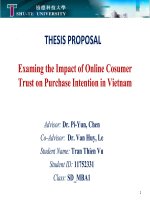
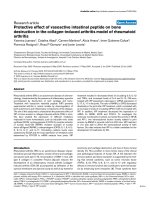

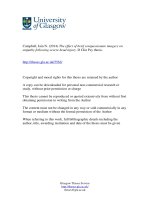
![gold et al - 2012 -the effect of engagement and review partner tenure and rotation on audit quality - evidence from germany [mapr]](https://media.store123doc.com/images/document/2015_01/06/medium_YF2viUqvRF.jpg)
![ionescu - 2014 - the effect of mandatory partner rotation on audit quality [mapr]](https://media.store123doc.com/images/document/2015_01/06/medium_fam1420548198.jpg)
